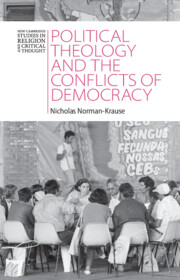494 results
Introduction
-
- Book:
- Political Theology and the Conflicts of Democracy
- Published online:
- 21 March 2025
- Print publication:
- 03 April 2025, pp 1-34
-
- Chapter
- Export citation

Political Theology and the Conflicts of Democracy
-
- Published online:
- 21 March 2025
- Print publication:
- 03 April 2025
The effects of conflict budget on the intensity of conflict: an experimental investigation
-
- Journal:
- Experimental Economics / Volume 23 / Issue 1 / March 2020
- Published online by Cambridge University Press:
- 14 March 2025, pp. 240-258
-
- Article
-
- You have access
- Open access
- HTML
- Export citation
Violence against Muslims: Conquered, Not Fully Colonized, in the Making of the Muslim “Other” in the Central African Republic
-
- Journal:
- African Studies Review , First View
- Published online by Cambridge University Press:
- 12 March 2025, pp. 1-23
-
- Article
-
- You have access
- Open access
- HTML
- Export citation
10 - Chapter
-
- Book:
- Dark Justice
- Published online:
- 07 March 2025
- Print publication:
- 06 March 2025, pp 69-76
-
- Chapter
- Export citation
12 - Chapter
-
- Book:
- Dark Justice
- Published online:
- 07 March 2025
- Print publication:
- 06 March 2025, pp 82-88
-
- Chapter
- Export citation
14 - Intergroup Conflict and Dehumanization
- from Part III - Behavior
-
-
- Book:
- The Cambridge Handbook of Moral Psychology
- Published online:
- 20 February 2025
- Print publication:
- 27 February 2025, pp 331-353
-
- Chapter
- Export citation
Improving Humanitarian Emergency Medical Team Operations in Conflict Settings
-
- Journal:
- Disaster Medicine and Public Health Preparedness / Volume 19 / 2025
- Published online by Cambridge University Press:
- 24 February 2025, e45
-
- Article
- Export citation
A Qualitative Analysis of Opportunities to Strengthen Coordination Between Humanitarian Mine Action and Emergency Care for Civilian Casualties of Explosive Injury
-
- Journal:
- Disaster Medicine and Public Health Preparedness / Volume 19 / 2025
- Published online by Cambridge University Press:
- 20 February 2025, e37
-
- Article
-
- You have access
- Open access
- HTML
- Export citation
Behavioral types of the dark side: identifying heterogeneous conflict strategies
-
- Journal:
- Journal of the Economic Science Association / Volume 7 / Issue 1 / September 2021
- Published online by Cambridge University Press:
- 17 January 2025, pp. 49-63
-
- Article
- Export citation
6 - High-Performing Global Teams
- from Part II - Leading People across Contexts
-
- Book:
- International Management Behavior
- Published online:
- 15 March 2025
- Print publication:
- 16 January 2025, pp 179-210
-
- Chapter
- Export citation
Chapter 7 - Communicating workplace change, conflict management and negotiation
- from Part 2 - Communicating in organisations
-
- Book:
- Communication Skills for Business Professionals
- Published online:
- 25 February 2025
- Print publication:
- 15 January 2025, pp 163-188
-
- Chapter
- Export citation

Schopenhauer's Politics
-
- Published online:
- 09 January 2025
- Print publication:
- 23 January 2025
-
- Book
-
- You have access
- Open access
- Export citation
7 - Turkey Turns
- from Part III - Twenty-First Century
-
- Book:
- Contesting Pluralism(s)
- Published online:
- 19 December 2024
- Print publication:
- 02 January 2025, pp 218-253
-
- Chapter
- Export citation
2 - The WPS Agenda and UN Mediation
-
- Book:
- The Politics of Women, Peace, and Security in UN Mediation
- Published online:
- 19 December 2024
- Print publication:
- 02 January 2025, pp 32-60
-
- Chapter
- Export citation
5 - The Art of UN Mediation
- from Part II - Practices
-
- Book:
- The Politics of Women, Peace, and Security in UN Mediation
- Published online:
- 19 December 2024
- Print publication:
- 02 January 2025, pp 121-138
-
- Chapter
- Export citation
4 - The Science of UN Mediation
- from Part II - Practices
-
- Book:
- The Politics of Women, Peace, and Security in UN Mediation
- Published online:
- 19 December 2024
- Print publication:
- 02 January 2025, pp 89-120
-
- Chapter
- Export citation
3 - Art or Science? Narrative Struggles over the Meaning of UN Mediation
- from Part I - Narratives
-
- Book:
- The Politics of Women, Peace, and Security in UN Mediation
- Published online:
- 19 December 2024
- Print publication:
- 02 January 2025, pp 63-86
-
- Chapter
- Export citation
The Determinants of Insurgent Gender Governance
-
- Journal:
- International Organization / Volume 79 / Issue 1 / Winter 2025
- Published online by Cambridge University Press:
- 12 March 2025, pp. 36-80
- Print publication:
- Winter 2025
-
- Article
-
- You have access
- Open access
- HTML
- Export citation
1 - Weaponizing Displacement in Civil Wars
-
- Book:
- Guilt by Location
- Published online:
- 12 December 2024
- Print publication:
- 19 December 2024, pp 1-25
-
- Chapter
-
- You have access
- HTML
- Export citation


